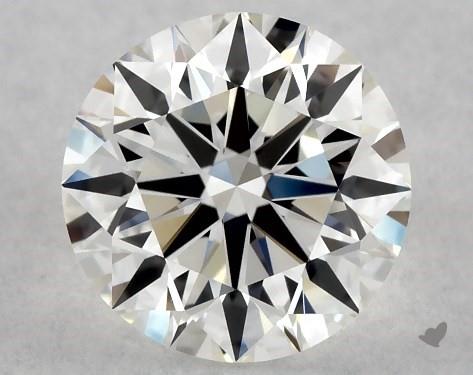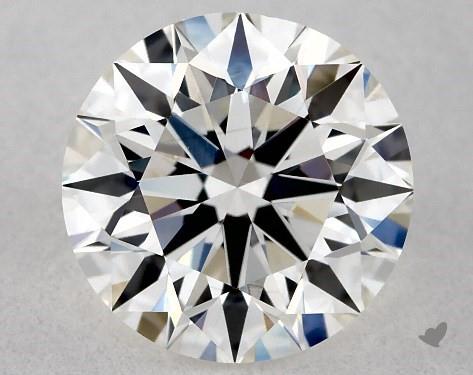Do VVS Diamonds Worth It?
There is a problem with VVS diamonds you need to know before buying them...
- Home /
- Diamond Education /
- VVS Diamonds
Everything You Need to Know About VVS Diamonds
The grade VVS falls pretty high on the GIA Clarity Scale. An acronym for Very Very Slightly Included, this descriptor can sound kind of vague to anyone who isn’t already well-versed in the unique world of diamonds.
VVS diamonds tend to be significantly more expensive than diamonds graded one step lower on the clarity scale (a VS diamond). For jewelers and collectors, there is a good reason for this high ticket price: while they are not quite as close to perfect as IF diamonds, their flaws are still very minor, and usually pretty difficult to spot without some kind of magnification.
Two 1 Carat Diamonds with G Color.
One has VVS1 Clarity and costs roughly $7,700 and the other VS1 Clarity and costs roughly $6,300.
Which is which?
Still, is that a good enough reason to invest in one, or should you prioritize another of the four Cs when you go on the hunt for a diamond? Read more below.
What are VVS Diamonds?
VVS diamonds are ‘eye clean’, and inclusions and blemishes are only visible under magnification.
When diamonds are formed, the intense conditions beneath the earth’s mantle cause them to form inclusions – a term used to describe internal imperfections – and blemishes, which here refers to external imperfections. Blemishes may also be caused by the way they are cut and handled after being mined from the earth.
The GIA clarity scale is used internationally, as a way of demonstrating to buyers how close (or far) from flawless any given diamond is. When an expert is grading a diamond against the clarity scale, they will always view it under 10x magnification. Some inclusions and blemishes are so small that they require more than 10x magnification to see and, if this is the case, they are considered flawless (FL) – although, admittedly, these are incredibly rare.
The next step down, Internally Flawless (IF) means that the diamond shows no inclusions under 10x magnification, and only minor surface blemishes.
But what does VVS mean? VVS means that the diamond does have inclusions, but that these inclusions are incredibly minor, and will not impact the appearance of the diamond, or its light performance, in a way that is noticeable to the naked eye.
In other words, they are ‘eye clean’. They appear flawless – unless you’re an expert with a magnifying glass.
What is VVS1?
VVS can be split into two distinct grades, with VVS1 coming immediately after IF in the GIA clarity scale. To be considered VVS1, a diamond must of course be ‘eye clean’, and its inclusions must only be visible under magnification from the pavilion (the lower portion, usually characterised by the pointed ‘V’ shape) of the diamond.
What is VVS2?
VVS2 is the next step down. A diamond graded at this level will still be eye clean, but its imperfections will be greater in number, and visible from the crown of the diamond (only under 10x magnification, of course).
Are VVS Diamonds Expensive?
Yes, a VVS grade does fetch a much higher price. Two diamonds of more or less equal weight, color and cut could feature drastically different price points if one of them was graded at VVS, and the other, say, SI (Slightly Included).
The reason behind this is pretty simple. Flawless and Internally Flawless diamonds are incredibly hard to come by and, obviously, incur a dauntingly high cost. VVS diamonds represent the next best thing – and, while their cost is high, they are considerably more affordable than IF diamonds.
Do VVS Diamonds Sparkle More?
Yes and no. Many factors impact a diamond’s sparkle – or, more technically, its ‘brilliance’ – but clarity isn’t all that important.
When it comes to maximizing sparkle, the most important feature is cut. In general, the more proportionate and symmetrical facets a diamond has, the better its light performance will be. This is why round cuts are more sparkly than step cuts: light will be refracted much more within a multifaceted diamond, than in one that features fewer facets.
If large enough, inclusions and blemishes can interrupt the diamond’s light performance. We mentioned above that symmetry creates the best sparkle, and imperfections naturally disrupt the symmetry of a diamond. But, for this to be noticeable, a diamond would have to feature some pretty noticeable inclusions.
Inclusions and blemishes in step cut diamonds are more visible than they are in round or fancy cut diamonds, but a VS step cut diamond will still be of a very high quality.
So, yes, VVS diamonds do sparkle more than highly included diamonds. Still, any difference between a VVS diamond and, say, a VS diamond will not be visible to the naked eye.
Are VVS Diamonds Worth it?
In our opinion, no – and here’s why.
A diamond is a big investment, and it’s always tempting to take a ‘go big or go home’ approach to every feature of a diamond. The four Cs are, of course, all understood via grades that sort diamonds from ‘best’ to ‘worst’, and it stands to reason that the higher we can go on each of these grades, the better our investment will be.
Still, to acquire a VVS diamond with an impeccable color, a good carat weight and a perfect cut means spending thousands of dollars. Whether these sorts of numbers feel like big deal or not, the truth is that it’s possible – and logical – to invest more into some features than in others.
While carat weight and cut quality are two features that directly impact the ‘face value’ of the diamond, clarity is something that is only properly understood by an expert studying the diamond under magnification.
In essence, the aesthetic difference between a VVS and a VS diamond is minimal, but the difference in price is substantial. When mounted in jewelry, those features that we prize so highly in diamonds – the shape of the cut, the color and the fire and brilliance – will be far more important than the difference between VVS and VS.
Those who invest in VVS diamonds do so because they appreciate the prestige and technical value of the diamond – this is why they are popular among collectors and jewelers – not because it looks noticeably different on the wearer.
So, unless you have an unlimited budget for your diamond, remember that some features are more worthy of a big investment than others, and that eye cleanliness means just as much to the wearer as VVS means to the jeweler.


